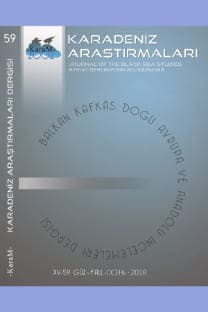ESKİ UYGURCA CHENG WEISHI LUNTEFSİRİNE İLİŞKİN BELGELER (2. VE 3. YAPRAK)
Eski Uygurca hem dinî hem de din dışı eserleri ihtiva etmesi bakımından tarihi Türkçenin önemli bir kolunu temsil eder. Dini eserleri Budizm, Manihaizm ve Nasturi Hristiyanlık gibi çevrelere ilişkin metinlerin tercümesi oluşturur. Bu dinler arasındaki yazınsal kaynaklar açısından en büyük pay Budizme aittir. Budizm birçok ekolü ve Budist külliyata ilişkin birçok eseriyle Eski Uygurca yazınında önemli bir yere sahiptir. Bu çalışma Eski Uygurca Cheng weishi lun tefsirine ilişkin üç fragmanın neşri hakkındadır. Burada neşri gerçekleştirilen fragmanlar Berlin BrandenburgBilimler Akademisi, Turfan Koleksiyonu’da Mainz 802-1 (b fragmanı) (T I D 1), Mainz 802-2 (b fragmanı) (T I D 2) ve U 1342 arşiv numaralarıyla saklanmaktadır. Bu fragmanlar Berlin Turfan Koleksiyonu’nda mevcut olan en az otuz bölümden oluşan Eski Uygurca bir yazmanın 21. bölümünü oluşturan Cheng weishi lun tefsirinin Eski Uygurca tercümesinin 2. ve 3. yapraklarını oluşturmaktadır. Bu yazıda yukarıda bahsi geçen Eski Uygurca fragmanların yazı çevirimleri, harf çevirimleri, Türkiye Türkçesine aktarımları ve analitik dizini ile sözlüğü sunulacaktır.
OLD UYGHUR DOCUMENTS OF A COMMENTARY OF CHENG WEISHI LUN(2NDAND 3RDLEAVES)
n terms of containing both religious and non-religious works, Old Uyghur represents an important branch of historical Turkic languages. Its religious works are translations of texts related to deverse religous environments such as Buddhism, Manihaism and Nestorian Christianity. The largest share in terms of literary sources among these religions belongs to Buddhism. Buddhism has an important place in Old Uyghur literature with its many schools and many works related to Buddhist literature. This paper is about the edition of three fragments related to Old Uyghur of a commentary of Cheng weishi lun. Fragments edited here are preserved at the Turfan Collection, in the Berlin Brandenburg Academy of Sciences under the archive numbers Mainz 802-1 (fragment b) (T I D 1), Mainz 802-2 (fragment b) (T I D 2) and U 1342. These fragments form the 2nd and 3rd leaves of Old Uighur translation of a commentary of Cheng weishi lun, which is the 21st chapter of an Old Uyghur handwritten manuscript consisting of at least thirty chapters in the Berlin Turfan Collection. In this paper, it will be presented the transcription and transliteration of Old Uyghur text, translation into Turkish, textual notes, and a glossary with analytical index.
___
- CLAUSON, S. G. (1972). An Etymological Dictionary of Pre-Thirteenth-Century Turkish. Oxford: Oxford at the Clarendon Press.
- DANKOFF, R. - J. KELLY (1984). Maḥmūd al-Kāšγarī. Compendium of Turkic Dialects (Dīwān Luγāt at-Turk). Part II. Duxbury, Massachusetts: Harvard University (Sources of Oriental Languages and Literatures. 7. Turkish Sources. VII).
- EDGERTON, F. (1953). Buddhist Hybrid Sanskrit Grammar and Dictionary, C. II: Dictionary, New Haven: Yale University Press.
- KLIMKEIT, H. J. (1990). “Buddhism in Turkish Central Asia”. Numen. 37: 53-69.
- MONIER-WILLIAMS, M. (1899). A Sanskrit-English Dictionary. Oxford: Oxford University Press.
- ÖZERTURAL, Z. (2012). Alttürkische Handschriften Teil 16: Mahāyāna-sūtras und Kommentartexte. Franz Steiner, Stuttgart (Verzeichnis der Orientalischen Handschriften in Deutschland. XIII, 24).
- ÖZERTURAL, Z. – K. RÖHRBORN (2020). Uigurisches Wörterbuch. Sprachmaterial der vorislamischen türkischen Texte aus Zentralasien, I. Verben. Band 2: edäd- – iztä-. Stuttgart: Steiner.
- RÖHRBORN, K. (1977-1998). Uigurisches Wörterbuch. Sprachmaterial der Vorislamischen Türkischen Texte aus Zentralasien. 1-6. Wiesbaden: Steiner.
- RÖHRBORN, K. (2010). Uigurisches Wörterbuch. Sprachmaterial der Vorislamischen Türkischen Texte aus Zentralasien, Neubearbeitung. I. Verben. Band. 1: ab- - äzüglä-. Stuttgart: Steiner.
- RÖHRBORN, K. (2015). Uigurisches Wörterbuch. Sprachmaterial der Vorislamischen Türkischen Texte aus Zentralasien. Neubearbeitung. II. Nomina-Pronomina-Partikel. Band 1: a-asvık. Stuttgart: Steiner.
- TOALSTER, J. P. C. (1977). Die uigurische Xuan-Zang-Biographie 4. Kapitel mit Übersetzung und Kommentar. Gießen: Justus Liebig-Universität. (Yayımlanmamış Doktora Tezi).
- WALTER, M. N. (2014). “Buddhism in Central Asian History”. The Wiley-Blackwell Companion to East and Inner Asian Buddhism. (ed. Mario Poceski). New Jersey: Blackwell Publishing: 21-39.
- İnternet Kaynakları
- Mainz 802-1 (b fragmanı) (T I D 1): [ön:] (Erişim Tarihi: 25.04.2020). http://turfan.bbaw.de/dta/mainz/images/mainz0802_seite2.jpg [arka:] (Erişim Tarihi: 25.04.2020). http://turfan.bbaw.de/dta/mainz/images/mainz0802_seite1.jpg
- Mainz 802-2 (b fragmanı) (T I D 2): [ön:] (Erişim Tarihi 25.04.2020). http://turfan.bbaw.de/dta/mainz/images/mainz0802_seite2.jpg [arka:] (Erişim Tarihi: 25.04.2020). http://turfan.bbaw.de/dta/mainz/images/mainz0802_seite1.jpg
- U 1342: [ön:] (Erişim Tarihi: 25.04.2020). http://turfan.bbaw.de/dta/u/images/u1342seite1.jpg [arka:] (Erişim Tarihi: 25.04.2020). http://turfan.bbaw.de/dta/u/images/u1342seite2.jpg
- ISSN: 2536-5126
- Yayın Aralığı: Yılda 4 Sayı
- Başlangıç: 2004
- Yayıncı: Osman Karatay
Sayıdaki Diğer Makaleler
BİR HAFIZA MEKANI OLARAK UZUNYAYLA’NIN PINARBAŞI İLÇESİNE BAĞLI ABAZA VE ÇERKES KÖYLERİ
ABDULLAH TEMİZKAN, Didem ÇATALKILIÇ
BULGARİSTAN’DA YILMAZ BİR JÖN TÜRK: EDHEM RUHİ BALKAN ve BALKAN GAZETESİ (1907-1908)*
BULGARİSTAN’DA YILMAZ BİR JÖN TÜRK:EDHEM RUHİ BALKAN ve BALKANGAZETESİ (1907-1908)
I. DÜNYA SAVAŞI YILLARINDA MACAR BASININDA KAFKASYA CEPHESİ (Vasárnapi Ujság Örneği)
ESKİ UYGURCA CHENG WEISHI LUNTEFSİRİNE İLİŞKİN BELGELER (2. VE 3. YAPRAK)
TONYUKUK YAZITINDA GEÇEN “oruk” SÖZCÜĞÜNÜN ETİMOLOJİSİ VE BAĞLAM ANLAMI
SOĞUK SAVAŞSONRASI RUS İSTİHBARAT TOPLULUĞUNUN DÖNÜŞÜMÜ (1991-1993)
THE TRANSFORMATION OF RUSSIAN INTELLIGENCE COMMUNITY AFTER THE COLD WAR (1991-1993)
